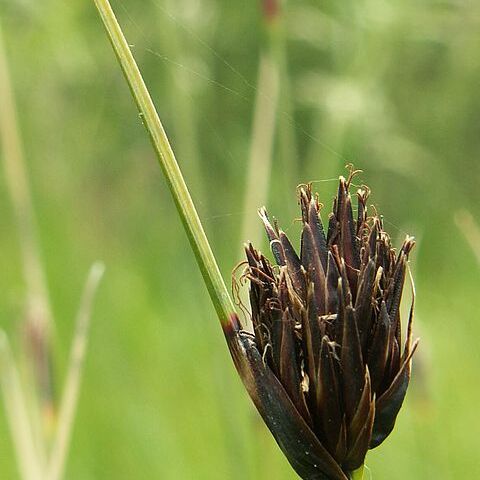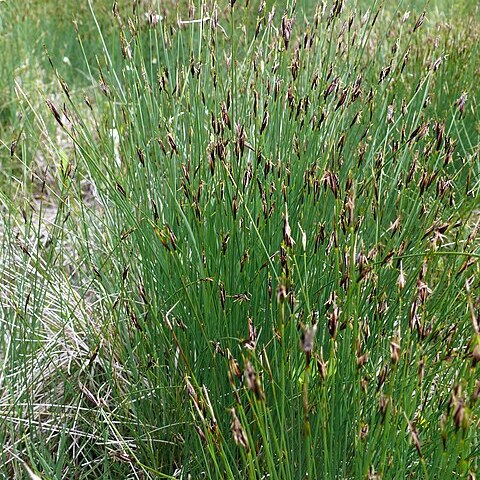Perennial tufted herbs, 0.1–0.55 m high; plants clonal, usually forming dense tussocks 0.05–0.2 m across; rhizome thin, woody, short, branched, 0.8–3.4 mm diam., pseudobulbous; old leaf sheaths covering the rhizome, usually breaking apart into fine fibres with age, straw-coloured to reddish brown; roots sand-binding or not. Culms slender, rigid, erect, 11–53 cm tall, 0.6–2.5 mm wide, not noded, terete to compressed, usually sulcate when dried, smooth, glabrous, green to yellow-green, base not enlarged. Leaves all basal, numerous; phyllotaxy loosely spirotristichous; sheath 20–70 mm long, 0.7–2.7 mm wide, broader than the leaf lamina, glabrous or scabrid, straw-coloured to reddish brown, dull, upper margin membranous, oblique, ligule absent; cauline sheath tight around culm; pseudopetiole obscure or absent; leaves with a well-developed lamina, not exceeding the culms, lamina dorsiventral, 4–21 cm long, 0.3–0.9 mm wide; bases white or brown-membranous, sometimes dividing; lamina ± linear, flat to channelled above, ± flexuous, old leaf tips usually curling, finely multi-striate, glabrous except for margins, green to brown, concolorous, keeled along mid-vein or not, margins scaberulous, not recurved, apex long-attenuate, setaceous; lowest leaves reduced to a sheath, lamina reduced to a mucro, pale to reddish brown. Inflorescence very contracted, panicle-like or subcapitate and appearing head-like, straight to somewhat flexuous, with 2–6 nodes, 0.5–1.7 cm long, 6–16 mm wide, not interrupted; bracts leaf-like, greatly exceeding the spikelet clusters in length, sheaths in the lower part of the inflorescence open, not or sometimes enveloping the higher bracts, gradually reducing along the inflorescence and often mostly hidden among the spikelets, basal bract spreading to suberect, similar to the leaves, much longer than the inflorescence, to 65 mm long; branches erect to spreading, with 2–5 spikelets in a terminal cluster, spikelet(s) on short, terete, glabrous peduncles 0.2–1.4 mm long, arising in each bract axil; basal branchlet 4.5–6.6. mm long (including spikelets); spikelet prophyll present, sheath 0.9–1.5 mm long, brown, partially enclosing the spikelet, with a slender lamina 0.2–1.6 mm long, brown. Spikelets pale to dark brown or chestnut, narrow-ovate, 4.7–8 mm long, 1.2–3.2 mm wide, terete, with 5–9 glumes, only topmost 1 or 3 fertile, the lower 2 flowers when present male fertile, the upper flower bisexual, fertile, no reduced glume above the florets; glumes spirodistichous, basal glume 2.6–4.2 mm long, fertile glumes 3.8–6.2 mm long, 0.9–1.6 mm wide, membranous, pale to dark brown or chestnut, lamina puberulent or glabrous, keel and margins scaberulous, ciliate or denticulate, acute or attenuate, often sparsely scabrous on the keel, usually ciliate on the margins, lamina glabrous, ovate-lanceolate, acute to acuminate or obtuse, with a mucro 0.3–1.2 mm long, keel distinct; rachilla compact and not sinuous in fruiting spikelets. Perianth segments 6, whitish, minute, ± linear, flat to terete, margins with dense to scattered, white, short, antrorse, ciliate or ciliate-plumose hairs, persistent on the nutlet. Stamens 3; anther connective 2.0–6.2 mm long, linear to subulate; anthers yellow, 1.8–3.1 mm long, twisted when dry, with a glabrous apical appendage 0.5–0.8 mm long. Style trifid, base 1.4–3.5 mm long, glabrous, slender throughout, branches 1.3–2.9 mm long, hispidulous. Nutlet stipitate, stipe 0.3–0.5 mm long, somewhat constricted, obovoid to obpyriform, obscurely trigonous, dull, brown to dark brown, reddish brown or grey, 1.4–2.3 mm long including the stipe and style base, 1.0–1.4 mm diam., faces irregularly reticulate to rugulose or tuberculate at 40× magnification, shortly hispidulous to scabrous or tuberculate at the apex, otherwise glabrous; epidermal cells usually square–hexagonal, inconspicuous, with three fine white ribs, style base not enlarged, thin, sometimes part of the base persistent, cylindrical; embryo Schoenus-type. Photosynthetic pathway inferred from anatomy to be C3. 1C = 0.26 pg for C. turbinata (K.L. Wilson 10781; Bureš et al. 2013).
More
Perennials with woody, abbreviated or shortly creeping rhizome, more rarely annuals. Stems erect, or ascending and rooting at the nodes, terete or obtusely trigonous, striate or sulcate, usually smooth. Leaves either all basal, or basal and cauline, linear, often setaceous, canaliculate, sometimes reduced to mucronate sheaths; ligule absent; basal sheaths open, dark-coloured; sheaths of the cauline leaves closed, tubular, often bearded at the mouth. Inflorescence terminal, racemose or paniculate, consisting of some distant fascicles of branches subtended by a leafy bract, or contracted and head-like. Spikelets solitary or clustered, (in the Malesian spp.) compressed, lanceolate to oblong-lanceolate, sometimes falcate, usually few-flowered. Rachilla straight and with very short internodes in the lower part (between the empty glumes), the upper internodes (between the fertile glumes) elongated and prominently zigzag. Glumes distichous, acropetally caducous, 1-nerved, keeled, frequently dark-coloured, the lower ones empty, the upper (flower-bearing) ones usually decurrent on the rachilla ('rachilla winged'), the terminal one often strongly reduced and empty. Flowers in the hollows of the zigzag rachilla, usually bisexual, but the uppermost often more or less reduced (male or functionally male). Perigone consisting of up to 6 filiform or linear-lanceolate, ciliate to plumose or antrorsely scabrous bristles, or absent. Stamens (1-)3(-6), (in Mal. (2-)3); anthers linear, with more or less produced glabrous connective. Style slender, continuous with the ovary, not or hardly dilated at the base, brown, caducous (often the very base remaining on the nut as an apiculus not separated from the nut proper by a constriction). Stigmas 3 (very rarely 2). Nut sessile or shortly stipitate, ovoid, obovoid, or ellipsoid, trigonous, often 3-ribbed, very rarely biconvex, glabrous, or hispidulous in the upper part, smooth, rugulose, or scrobiculate; epidermal cells isodiametric to oblong.
Infl. paniculate, or capitate, or a solitary spikelet. Spikelets 1–4-fld, sessile or stalked, fls hermaphrodite, or the uppermost functionally male; rhachilla flexuous or zig-zag between the fls; glumes distichous, keeled, us. nerveless except for a central midrib, some lower glumes and some upper ones often empty. Hypog. bristles 6–1, plumose or ciliate, us. scabrid; or 0. Stamens 3, occ. 2. Style-branches 3, occ. 2. Nut ± trigonous, angles ± thickened. Perennial herbs, with or without creeping rhizomes, or rarely annual. Culms erect, curved, or drooping and rooting below, terete or compressed, branched or unbranched. Lvs basal or cauline, narrow-linear, setaceous and rigid, or flaccid, margins of lamina us. slightly toothed; or all, or the basal lvs reduced to sheathing, us. mucronate bracts. About 100 spp. of temperate regions. Of the 8 N.Z. spp., 2 are endemic; the other 6 occur in Australia as well and 3 of these are recorded from elsewhere in the Pacific.


